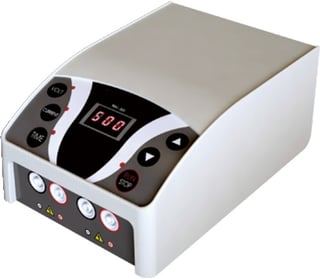 The choice of constant current or constant voltage will depend on several different factors that must be taken into consideration for each Western transfer test. The level of heat, duration of the test, type of proteins, the size of the transfer, and the rate of transfer will all be affected by power, voltage, and current being used to drive the test. Each factor will play a role in how well the proteins transfer and the ultimate accuracy of the test.
The choice of constant current or constant voltage will depend on several different factors that must be taken into consideration for each Western transfer test. The level of heat, duration of the test, type of proteins, the size of the transfer, and the rate of transfer will all be affected by power, voltage, and current being used to drive the test. Each factor will play a role in how well the proteins transfer and the ultimate accuracy of the test.
While some people prefer the use of constant voltage, others will choose constant current. Both have advantages and disadvantages, but the choice should be based on which one best suits the test and the desired final results.
Constant Voltage
One of the main benefits of using constant voltage is that the field strength of the test does not change. Although the temperature during the test may rise, maintaining sufficient drive during the run will offer the most efficiency. Using the cooling systems associated with most tanks can help dissipate the heat and maintain a constant temperature throughout the test. When constant voltage is used, the current will continue to increase as the resistance begins to decrease. The decrease in resistance is due to the heat that is produced during the transfer. When a semi-dry system is being used, the depletion of the buffer will cause the current to drop. Using constant voltage allows proteins to separate according to their level of mobility, while with constant current, all proteins transfer equally.
Constant Current
Using constant current increased the length of time it takes to complete the test. In some cases, this can mean several hours or overnight. When constant current is used the resistance continues to decrease. This, in turn, results in a decrease in the amount of voltage and power that is required to perform the test over time. The amount of heat that is produced is kept to a minimum and will not have a direct impact on the results of the transfer. The apparatus being used and the types of proteins being transferred will determine the amount of current that is used and the length of time it takes to perform the transfer.
Constant Power
Constant power can be used in place of constant current if the regulation and the disbursement of heat becomes an issue. When constant power is used, the change in resistance will work to increase the amount of current that drives the test. It is important to remember that the amount of heat produced during a transfer will be directly related to the amount of power that is dissipated throughout the test. When constant power is used, the amount of heat generated will remain the same, unlike when constant voltage is used and the heat steadily increases.
Power, current, and voltage result in different rates of transfer based on the size and type of buffers used within the testing protocols. The choice between the three will be determined by the protocols of each test and the desired or expected results. It is important to determine at what levels each of the three should be used during a test. In most cases, it is advisable to perform a test run to determine if the resulting transfer will provide beneficial and accurate results. If the bands appear to be weak of if the proteins are not transferring as well as desired, the current or voltage may need to be adjusted. It may take several dry runs before the exact settings can be determined and the final test can be performed.






